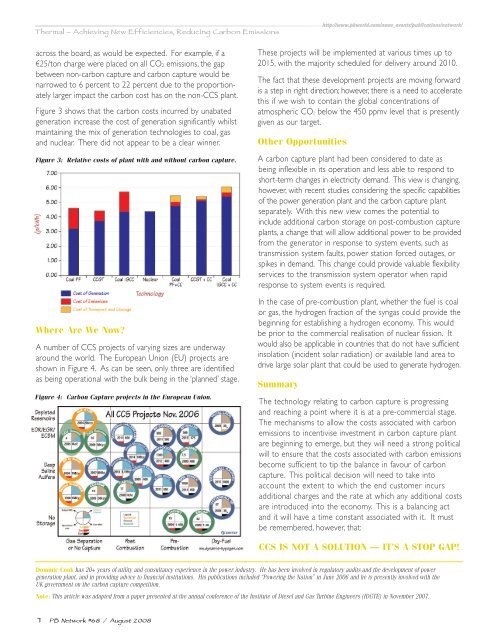Innovation in Global Power - Parsons Brinckerhoff
Innovation in Global Power - Parsons Brinckerhoff
Innovation in Global Power - Parsons Brinckerhoff
You also want an ePaper? Increase the reach of your titles
YUMPU automatically turns print PDFs into web optimized ePapers that Google loves.
Thermal – Achiev<strong>in</strong>g New Efficiencies, Reduc<strong>in</strong>g Carbon Emissions<br />
http://www.pbworld.com/news_events/publications/network/<br />
across the board, as would be expected. For example, if a<br />
€25/ton charge were placed on all CO2 emissions, the gap<br />
between non-carbon capture and carbon capture would be<br />
narrowed to 6 percent to 22 percent due to the proportionately<br />
larger impact the carbon cost has on the non-CCS plant.<br />
Figure 3 shows that the carbon costs <strong>in</strong>curred by unabated<br />
generation <strong>in</strong>crease the cost of generation significantly whilst<br />
ma<strong>in</strong>ta<strong>in</strong><strong>in</strong>g the mix of generation technologies to coal, gas<br />
and nuclear. There did not appear to be a clear w<strong>in</strong>ner.<br />
Figure 3: Relative costs of plant with and without carbon capture.<br />
Where Are We Now?<br />
A number of CCS projects of vary<strong>in</strong>g sizes are underway<br />
around the world. The European Union (EU) projects are<br />
shown <strong>in</strong> Figure 4. As can be seen, only three are identified<br />
as be<strong>in</strong>g operational with the bulk be<strong>in</strong>g <strong>in</strong> the ‘planned’ stage.<br />
Figure 4: Carbon Capture projects <strong>in</strong> the European Union.<br />
These projects will be implemented at various times up to<br />
2015, with the majority scheduled for delivery around 2010.<br />
The fact that these development projects are mov<strong>in</strong>g forward<br />
is a step <strong>in</strong> right direction; however, there is a need to accelerate<br />
this if we wish to conta<strong>in</strong> the global concentrations of<br />
atmospheric CO2 below the 450 ppmv level that is presently<br />
given as our target.<br />
Other Opportunities<br />
A carbon capture plant had been considered to date as<br />
be<strong>in</strong>g <strong>in</strong>flexible <strong>in</strong> its operation and less able to respond to<br />
short-term changes <strong>in</strong> electricity demand. This view is chang<strong>in</strong>g,<br />
however, with recent studies consider<strong>in</strong>g the specific capabilities<br />
of the power generation plant and the carbon capture plant<br />
separately. With this new view comes the potential to<br />
<strong>in</strong>clude additional carbon storage on post-combustion capture<br />
plants, a change that will allow additional power to be provided<br />
from the generator <strong>in</strong> response to system events, such as<br />
transmission system faults, power station forced outages, or<br />
spikes <strong>in</strong> demand. This change could provide valuable flexibility<br />
services to the transmission system operator when rapid<br />
response to system events is required.<br />
In the case of pre-combustion plant, whether the fuel is coal<br />
or gas, the hydrogen fraction of the syngas could provide the<br />
beg<strong>in</strong>n<strong>in</strong>g for establish<strong>in</strong>g a hydrogen economy. This would<br />
be prior to the commercial realisation of nuclear fission. It<br />
would also be applicable <strong>in</strong> countries that do not have sufficient<br />
<strong>in</strong>solation (<strong>in</strong>cident solar radiation) or available land area to<br />
drive large solar plant that could be used to generate hydrogen.<br />
Summary<br />
The technology relat<strong>in</strong>g to carbon capture is progress<strong>in</strong>g<br />
and reach<strong>in</strong>g a po<strong>in</strong>t where it is at a pre-commercial stage.<br />
The mechanisms to allow the costs associated with carbon<br />
emissions to <strong>in</strong>centivise <strong>in</strong>vestment <strong>in</strong> carbon capture plant<br />
are beg<strong>in</strong>n<strong>in</strong>g to emerge, but they will need a strong political<br />
will to ensure that the costs associated with carbon emissions<br />
become sufficient to tip the balance <strong>in</strong> favour of carbon<br />
capture. This political decision will need to take <strong>in</strong>to<br />
account the extent to which the end customer <strong>in</strong>curs<br />
additional charges and the rate at which any additional costs<br />
are <strong>in</strong>troduced <strong>in</strong>to the economy. This is a balanc<strong>in</strong>g act<br />
and it will have a time constant associated with it. It must<br />
be remembered, however, that:<br />
CCS IS NOT A SOLUTION — IT’S A STOP GAP!<br />
Dom<strong>in</strong>ic Cook has 20+ years of utility and consultancy experience <strong>in</strong> the power <strong>in</strong>dustry. He has been <strong>in</strong>volved <strong>in</strong> regulatory audits and the development of power<br />
generation plant, and <strong>in</strong> provid<strong>in</strong>g advice to f<strong>in</strong>ancial <strong>in</strong>stitutions. His publications <strong>in</strong>cluded “<strong>Power</strong><strong>in</strong>g the Nation” <strong>in</strong> June 2006 and he is presently <strong>in</strong>volved with the<br />
UK government on the carbon capture competition.<br />
Note: This article was adapted from a paper presented at the annual conference of the Institute of Diesel and Gas Turb<strong>in</strong>e Eng<strong>in</strong>eers (IDGTE) <strong>in</strong> November 2007.<br />
7 PB Network #68 / August 2008

















